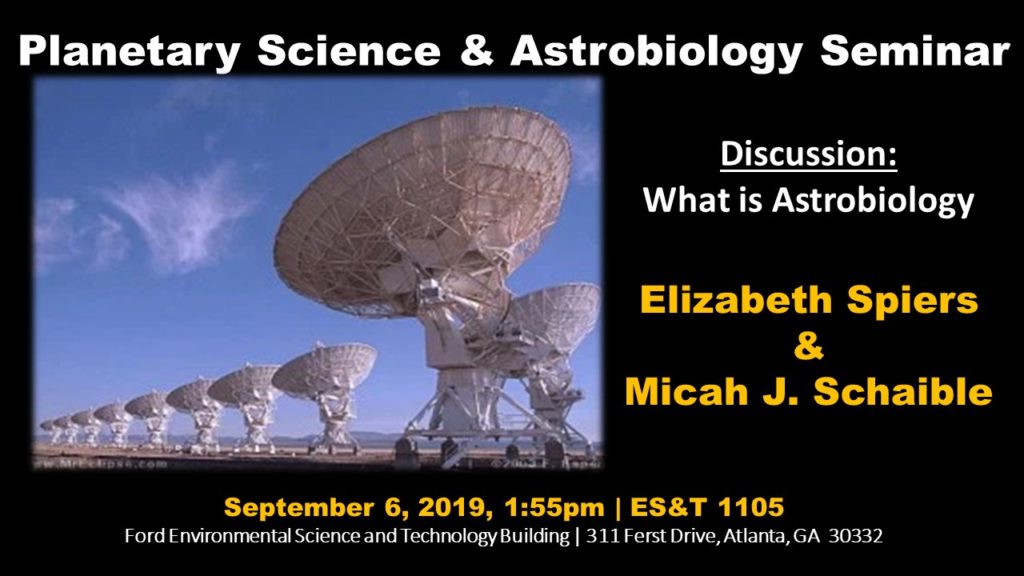
09/06/2019: “What is Astrobiology” Elizabeth Spiers and Micah Schaible (GT)

09/06/2019: “What is Astrobiology” Elizabeth Spiers and Micah Schaible (GT)
June 2019
Dr. Denise Okafor, currently a postdoctoral fellow at Emory University, will be starting as an assistant professor in the Penn State Department of Biochemistry and Molecular Biology in January 2020. Dr Okafor graduated from Georgia Tech with a PhD in Biochemistry in 2015. She worked on research related to the origin of life in the Williams and Hud labs. Dr Okafor was featured as one of six GT College of Sciences alumni during the 2019 Georgia Tech Homecoming. Read more about Dr. Okafor’s research accomplishments here.
May 2019
Georgia Tech graduate students now have another way to join the hot field of astrobiology. The Graduate Certificate in Astrobiology is now an option, thanks to the effort of the vibrant astrobiology community in Georgia Tech. Read the full news story here.
March 2019
The College of Sciences is the proud host of six NPP fellows advancing NASA’s mission in astrobiology and solar system exploration. The concentration of talent testifies to Georgia Tech’s vibrant astrobiology and space science research communities. Meet the six NPP fellows whose scientific career paths are being shaped by their mentors in the College of Sciences.
Kennda Lynch is a postdoctoral researcher in Georgia Tech’s School of Earth and Atmospheric Sciences and has just been featured in season two of Science Matters. She studies ancient lakes on Earth that serve as stand-ins for Mars’s formerly-flooded craters. Lynch’s work helps NASA identify potential landing sites on the red planet.
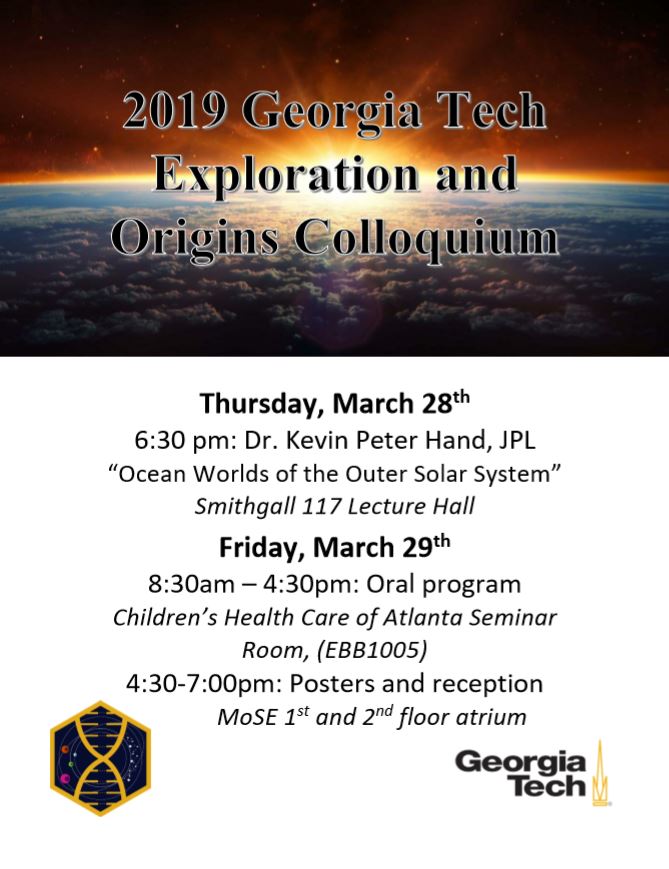
Thursday, March 28
“Ocean Worlds of the Outer Solar System”
Public Lecture and reception
Dr. Kevin Hand, NASA JPL
Smithgall 117 Lecture Hall, 353 Ferst Drive NW, Atlanta, GA 30313, 6:30pm with reception to follow
Friday, March 29
Topic: Planetary Science and Exploration
Topic: Life Origins and its Detection
Building on the success of the 2018 Astrobiology Colloquium, Georgia Tech Astrobiology and ExplOrigins groups are proud to announce the 2019 Exploration and Origins Colloquium, which will take place on March 28-29, 2019. This is the 2nd annual networking event under the theme of exploring the universe and origins of life.
This year the colloquium is split in two sections: the first section is focused on space exploration technology and planetary science, and the second is oriented toward the chemistry and biology of the origins and the search for life. The event will consist of presentations and talks by early career scientists, i.e. graduate and undergraduate students, and post-doctoral fellows, working in the exciting fields of space and planetary science, engineering and astrobiology across Georgia Tech campus and the greater Atlanta. There will also be plenary lectures given by distinguished members of the global astrobiology community. The objective of this interdisciplinary colloquium is to forge connections across the kinds of research at Georgia Tech straddling the boundaries between technology development and hypothesis testing in the search for life’s beginnings and to explore collaborative ideas among participants. Hence, senior researchers and faculty are also highly encouraged to attend.
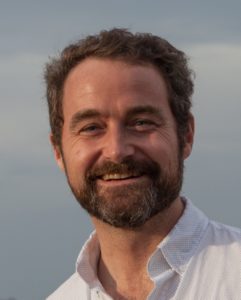
Dr. Kevin Peter Hand is a planetary scientist at NASA’s Jet Propulsion Laboratory in Pasadena, California. His research focuses on the origin, evolution, and distribution of life in the solar system with an emphasis on Jupiter’s moon, Europa. His work involves both theoretical and laboratory research on the physics and chemistry of icy moons in the outer solar system. Hand is the Director of the Ocean Worlds Lab at JPL. He served as co-chair for NASA’s Europa Lander Science Definition team and he is the Project Scientist for the Pre-Phase-A Europa Lander mission. From 2011 to 2016 he served as Deputy Chief Scientist for Solar System Exploration at JPL. He served as a member of the National Academies Committee on Astrobiology and Planetary Sciences. His work has brought him to the Dry Valleys of Antarctica, the sea ice near the North Pole, the depths of the Earth’s oceans, and to the glaciers of Kilimanjaro. Dr. Hand was a scientist onboard James Cameron’s 2012 dive to the bottom of the Mariana Trench, and he was part of a 2003 IMAX expedition to hydrothermal vents in the Atlantic and Pacific oceans. He has made nine dives to the bottom of the ocean. In 2011 he was selected as a National Geographic Explorer. Hand earned his PhD from Stanford University and bachelor’s degrees from Dartmouth College. He was born and raised in Manchester, Vermont.
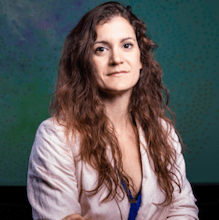
Professor Walker is an astrobiologist and theoretical physicist at Arizona State University, the Deputy Director of the Beyond Center for Fundamental Concepts in Science, and the Associate Director of the ASU-Santa Fe Institute Center for Biosocial Complex Systems. She is also Co-founder of the astrobiology-themed social website SAGANet.org, and a member of the Board of Directors of Blue Marble Space. Her work centers on in the origin of life and how to find life on other worlds. She is most interested in whether or not there are ‘laws of life’ – related to how information structures the physical world – that could universally describe life here on Earth and on other planets. She is active in public engagement in science, with appearances at the World Science Festival and on “Through the Wormhole” and NPR’s Science Friday
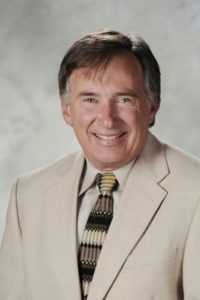
Professor Steffes performed his doctoral research at Stanford University where he concentrated on microwave radio occultation experiments using the Voyager and Mariner spacecraft, with specific interest in microwave absorption in planetary atmospheres. Then, in 1982, he joined the faculty of Georgia Tech and is currently a Professor of Electrical and Computer Engineering. His research focuses on microwave and millimeter-wave remote sensing and radio astronomy and has been sponsored by NASA, the NSF, the SETI Institute and by industry. He has been involved with numerous NASA missions, including Pioneer-Venus, Magellan, the Advanced Communications Technology Satellite (ACTS), the High Resolution Microwave Survey (HRMS), and Juno (Jupiter Polar Orbiter).
Locations:
Kevin Hand Public Lecture “Ocean Worlds of the Outer Solar System”: Smithgall 117 Lecture Hall (Student Services Building), 353 Ferst Drive NW, Atlanta, GA 30313
Keynote and oral presentations will be in the Children’s Health Care of Atlanta Seminar Room (EBB 1005), Krone Engineered Biosystems Building (EBB), 950 Atlantic Drive, NW, Atlanta. GA 30332.
The poster session and networking event will be in held the 1stand 2nd floor atria of the Molecular Science and Engineering Building (MoSE), 901 Atlantic Drive NW, Atlanta, GA 30318.
For all questions, please contact us
We are grateful for funding and support from The Georgia Tech Strategic Plan Action Group (SPAG), the School of Earth and Atmospheric Sciences (EAS), The NSF/NASA Center for Chemical Evolution (CCE), The School of Chemical and Biomolecular Engineering, and the School of Chemistry and Biochemistry.
Continue reading “2019 Explorigins Colloquium”“AbGradCon (Astrobiology Graduate Conference) provides a unique setting for astrobiologically-inclined graduate students and early career researchers to come together to share their research, collaborate, and network. AbGradCon 2018 marks the 14th year of this conference–each time in a different place and organized by a different group of students, but always with the original charter as a guide.”
“These meetings have been wildly successful both when connected to AbSciCon, and as stand-alone conferences. Since it is organized and attended by only graduate students, post docs, and select undergraduates, AbGradCon is an ideal venue for the next generation of career astrobiologists to form bonds, share ideas, and discuss the issues that will shape the future of the field. Take a look at the AbGradCon 2017 conference website to see what’s happened in the past.”
Taken from official AbGradCon Site.
On September 23, 2017 the Life in the Cosmos symposium was attended by over 100 people.
While the symposium is now behind us, you can view select presentations from the program here.
Among the oldest questions conceived by humans are: What is the origin of life, and does life exist on other worlds? Georgia Tech will host a day-long public Symposium on Astrobiology and Society in Fall 2017 with sessions dedicated respectively to Origin and Evolution of Life on Earth and The Search for Life Beyond our Home Planet. Each session will be rounded out by a half-hour discussion led by a panel of distinguished scientists and humanists. Anticipating discoveries that will alter our very concept of life, astrobiology pushes us to reflect upon the meaning of “creation”, our place in it, and how to accommodate scientifically plausible alternatives to longstanding hypotheses and myths. While astrobiology is often presented to the public as ‘other worldly’, and can easily carry utopian visions of possibility and hope, the force of astrobiology is first and foremost terrestrial. The aura of new worlds reminds us that our cosmic ‘other worldly discoveries’ above all concern the planet on which we live. Analysis of data from vent plumes in our solar system or in Pacific Ocean trenches show the ways our solar system has become a laboratory for better understanding our own planet. The symposium and related interviews with participants will be recorded and provide substrate for a documentary that focuses on how astrobiology drives research across science and the humanities, and sparks open and imaginative discussion about Big Questions, including, What is life? What is the value of different life forms? What is humankind’s destiny?
Over 100 registered for this sold out program.
Keynote
Paul Steffes, Professor, School of Electrical and Computer Engineering, Georgia Tech
“How the Search for Extraterrestrial Intelligence has Evolved in the First Two Decades of the 21st Century”
8:30-9:00
Session A
Chair: Martha Grover, Professor, School of Chemical and Biomolecular Engineering
Nick Hud, Regents Professor, School of Chemistry and Biochemistry, Georgia Tech“Exploring the Origins of Life- From the Bottom Up”
9:00-9:20
Loren Williams, Professor, School of Chemistry and Biochemistry, Georgia Tech
“Exploring the Origins of Life- From the Top Down”
9:20-9:40
Eric Smith, External Professor, Santa Fe Institute
“Making Sense of Evolution in the Light of the Rest of Science”
9:40-10:00
Session B
Chair: Paul Sniegowski, Professor of Biology, University of Pennsylvania
William Ratcliff, Assistant Professor, School of Biological Sciences, Georgia Tech
“Exploring the Origin of Multicellularity through Experimental Evolution”
10:45-11:15
Jennifer Glass, Assistant Professor, School of Earth and Atmospheric Sciences, Georgia Tech
“Small but Mighty– How ‘Good’ Bacteria Transformed our Planet”
11:25-11:45
Shelley Copley, Professor, Department of Molecular, Cellular, and Developmental Biology, Cooperative Institute for Research in Environmental Sciences, UC Boulder
“Closely Related Species Follow Different Evolutionary Trajectories”
Lunch
12:15-1:45
Session C
Chair: Kennda Lynch, Postdoctoral Researcher, School of Earth and Atmospheric Sciences, Georgia Tech
James Wray, Assistant Professor, School of Earth and Atmospheric Sciences, Georgia Tech
“Upcoming Astrobiological Opportunities at Mars”
1:45-2:05
Carol Paty, Associate Professor, School of Earth and Atmospheric Sciences, Georgia Tech
“Searching for Europa’s Hidden Ocean”
2:05-2:25
Amanda Stockton, Assistant Professor, School of Chemistry and Biochemistry, Georgia Tech
“High Impact Chemistry- How to Find Life on Other Planets”
2:25-2:45
Gongjie Li, Junior Fellow, Department of Astronomy, Harvard University
“Searching for Habitable Exoplanets”
2:45-3:15
This full-day event was organized in partnership with the Leadership and Multifaith Program and is co-sponsored by Columbia Theological Seminary. The symposium aims to generate a multifaith discussion among scholars, clergy, community leaders, and students about science, spirituality, and the future of life on earth and elsewhere. Speakers will address this theme from diverse disciplinary perspectives, including cognitive science, religious studies, ecology, ecotheology, ethics, and astrobiology. The symposium will be held on February 17, 2018, at the Candler School of Theology at Emory University, located at 1531 Dickey Drive, Atlanta, GA 30322. Lunch is included, and a short reception will follow the final session. This event is free and open to the public. Registration is required.
Registration & Coffee (8:30 – 9:00 A.M.)
Keynote Address (9:30 A.M. – 10:45 A.M.)
Speaker: Arri Eisen, “What Happens When You Mix Monks, Nuns, and Scientists? The Emory Tibet Science Initiative”
Session 1: Life of the Mind-Body-Spirit (10:45 A.M. -12:15 P.M.)
Lunch (12:15-1:30 P.M.)
Session 2: Life Here on Earth (1:30 – 3:00 P.M.)
Session 3: Life in the Cosmos & Where We Go From Here (3:30 – 5:30 P.M.)
Speakers: Ken Knoespel, Loren Williams, Amanda Stockton, Britney Schmidt, Luju Ojha, Chris Reinhard, Lisa Yaszek
Where do we come from? Does life exist elsewhere in the universe? While the latter may seem like the stuff of 21st century science fiction, both questions have been integral to myriad cultures for millennia. Over the last decades however, research the life and physical sciences has brought these inquiries into the realm of science, and given rise to the field of astrobiology. But what do we know about our origins? And how do we search for life? The first part of this interactive symposium will introduce current scientific thought on the beginnings of our biochemistry, the evolution of our planet as a habitable system, and how we search for signs of life in space. The second half will explore the mutually influential roles science and science fiction, the implications of the discovery of water on Mars, and what life might look like on worlds far different than our own. Audience members are encouraged to come curious and ready with questions about the science and its place in our broader human context.